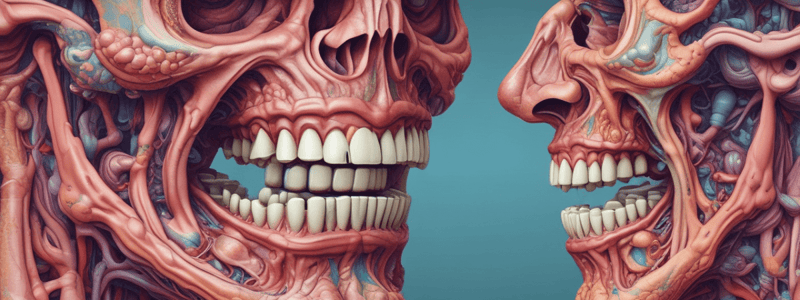Podcast
Questions and Answers
What is the total saliva flow rate in milliliters for 24 hours?
What is the total saliva flow rate in milliliters for 24 hours?
- 400 ml
- 800 ml
- 600 ml (correct)
- 700 ml
What is the percentage of contribution to whole mouth saliva by the parotid glands when stimulated?
What is the percentage of contribution to whole mouth saliva by the parotid glands when stimulated?
- 60%
- 46% (correct)
- 40%
- 52%
What is the unstimulated whole mouth salivary flow rate in milliliters per minute?
What is the unstimulated whole mouth salivary flow rate in milliliters per minute?
- 0.30 ml/min
- 0.25 ml/min
- 0.35 ml/min (correct)
- 0.40 ml/min
During which time period does the unstimulated whole mouth salivary flow rate increase by 70%?
During which time period does the unstimulated whole mouth salivary flow rate increase by 70%?
What is the contribution of the submandibular and sublingual glands to whole mouth saliva when stimulated?
What is the contribution of the submandibular and sublingual glands to whole mouth saliva when stimulated?
What is a possible consequence of having a decreased saliva flow rate?
What is a possible consequence of having a decreased saliva flow rate?
What is the primary function of salivary proteins in the acquired enamel pellicle?
What is the primary function of salivary proteins in the acquired enamel pellicle?
Which of the following salivary glands makes the greatest contribution to resting flow rate?
Which of the following salivary glands makes the greatest contribution to resting flow rate?
What is the role of salivary bicarbonate?
What is the role of salivary bicarbonate?
What is the primary function of histatins and defensins in saliva?
What is the primary function of histatins and defensins in saliva?
What is the role of calcium and phosphate in saliva?
What is the role of calcium and phosphate in saliva?
What is the primary function of mucins in saliva?
What is the primary function of mucins in saliva?
What is the main component of salivary fluid produced by the acinus?
What is the main component of salivary fluid produced by the acinus?
What is the role of salivary proteins in the enamel pellicle?
What is the role of salivary proteins in the enamel pellicle?
What is the importance of salivary bicarbonate concentration in maintaining teeth?
What is the importance of salivary bicarbonate concentration in maintaining teeth?
What happens to the pH of saliva when it decreases to approximately pH 5.5 due to dietary or plaque acid?
What happens to the pH of saliva when it decreases to approximately pH 5.5 due to dietary or plaque acid?
What is the role of saliva in regulating oral microbiota?
What is the role of saliva in regulating oral microbiota?
What is the effect of very low salivary flow on oral health?
What is the effect of very low salivary flow on oral health?
What is the role of the acquired enamel pellicle in tooth mineralization?
What is the role of the acquired enamel pellicle in tooth mineralization?
What is the role of salivary agglutinin in oral health?
What is the role of salivary agglutinin in oral health?
What is the composition of whole mouth saliva?
What is the composition of whole mouth saliva?
What is the role of carbonic anhydrase in saliva?
What is the role of carbonic anhydrase in saliva?
Flashcards are hidden until you start studying
Study Notes
Composition of Saliva
- Whole mouth saliva consists of biofilm, enamel/dentine, GCF (Gingival Crevicular Fluid), shed epithelial cells, and transudate
- Acinus produces salivary fluid containing water, electrolytes, blood proteins, and salivary proteins
- Ducts produce Na+, Cl-, and glandular salivas
Cells, Microorganisms, and Microparticles in Saliva
- Cells in saliva include epithelial cells and neutrophils
- Microorganisms in saliva include bacteria (10^8/ml), viruses, candida, and protozoa
- Microparticles in saliva include exosomes (increased flow and oral clearance)
Functions of Saliva
- Buffers pH and maintains enamel pellicle
- Protects and maintains oral mucosa through wound healing, lubrication, and barrier formation
- Regulates oral microbiota through clearance, killing, and agglutination of pathogens, and colonization, adhesion, and feeding of commensals
- Aids in taste and processing of food/nutrients
Flow Rate and Oral Clearance
- Very low salivary flow rate increases the risk of dental caries
- Buffering in saliva by bicarbonate involves the reaction: CO2 + H2O → H2CO3 → HCO3- + H+
Acquired Enamel Pellicle
- A thin layer (<1 μm) formed by calcium-binding salivary proteins (statherin, histatins, and acidic proline-rich proteins)
- Prevents surface mineralization and enhances sub-surface remineralization
- Lubrication reduces friction by 20-fold
Saliva and Tooth Mineralization
- Tooth apatite (Ca10(PO4)6OH2) is dependent on supersaturation of saliva with calcium and phosphate
- Concentration of Ca2+ in resting saliva is approximately 2mM
- Supersaturation of saliva with calcium and phosphate is due to salivary protein statherin
Saliva and Oral Mucosa
- Saliva forms a hydrated, barrier film on the oral mucosa
- Lubrication, barrier function, and interaction with the mucosal surface are essential
- Saliva regulates oral microorganisms by clearing microorganisms, modifying the adherence of microorganisms to teeth, and modulating microbial growth
Anti-Microbial Factors in Saliva
- Saliva contains anti-bacterial proteins (cystatins, histatins, defensins, cathelicidins, lysozyme, lactoferrin, lactoperoxidase, SLPI, chromogranin A, PLUNCs, immunoglobulins, mucins)
- Saliva also contains anti-fungal and anti-viral proteins
Summary
- Saliva enables oral tissues to cope with a range of problems associated with oral functions
- Resting (unstimulated) flow of saliva is crucial for oral health
- Submandibular and sublingual glands contribute the most to resting flow rate, while parotid glands contribute more to stimulated flow rate
- Saliva forms films and pellicles on hard and soft tissues in the mouth
Studying That Suits You
Use AI to generate personalized quizzes and flashcards to suit your learning preferences.




